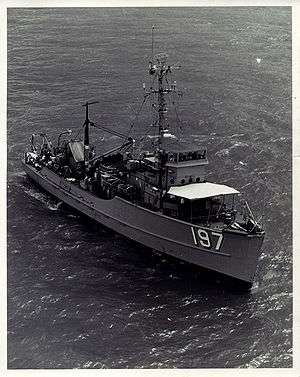USS Parrot (MSC-197)
 | |
| History | |
|---|---|
| Name: | USS Parrot |
| Builder: | Broward Marine Inc., Fort Lauderdale, Florida |
| Laid down: | 23 December 1953 |
| Launched: | 27 November 1954 |
| Commissioned: | 28 June 1955 |
| Decommissioned: | 26 September 1968 |
| In service: | 26 September 1968 |
| Out of service: | 20 July 1972 |
| Reclassified: | MSC–197, 7 February 1955 |
| Struck: | 1 August 1972 |
| Fate: | Sold for scrap, 1 December 1976 |
| General characteristics | |
| Class and type: | Falcon-class minesweeper |
| Displacement: | 362 long tons (368 t) |
| Length: | 144 ft 3 in (43.97 m) |
| Beam: | 27 ft 1 in (8.26 m) |
| Draft: | 12 ft (3.7 m) |
| Propulsion: | 2 × 600 shp (447 kW) Packard diesel engines, 2 shafts |
| Speed: | 13.6 knots (25.2 km/h; 15.7 mph) |
| Complement: | 39 |
| Armament: |
|
USS Parrot (AMS-197/MSC-197) was a Falcon-class minesweeper in the United States Navy. The Falcon class ships were named for birds, and MSC-197 was named after the parrot.
Parrot was laid down as AMS–197 on 23 December 1953 at Broward Marine Inc., Fort Lauderdale, Florida and launched on 27 November 1954; sponsored by Mrs. S. Heuer. Reclassified MSC–197 on 7 February 1955, and commissioned on 28 June 1955, Lt. (j.g.) R. K. Fontaine in command.
North Atlantic operations
After fitting out and training, Parrot, along with four other minesweepers, participated in cold weather minesweeping exercises in the North Atlantic. Parrot then moved to Charleston, South Carolina, her base for exercises and training operations in the Caribbean and the Gulf Stream. She remained there until January 1958, when she sailed north to participate in her first NATO exercise. In February, 1958, the Parrot was dispatched to the waters off Savannah, Georgia to participate in a search for a nuclear weapon jettisoned by a bomber. Upon completion, she returned to the Caribbean area where she remained into 1961, conducting training exercises and serving as training ship for the Mine Warfare School. In March 1961, she assisted in helping to evaluate the new helicopter method of minesweeping. After completion of this duty, she returned to her training and patrol duties.
On 22 October 1962, Parrot was ordered to get underway, with no destination being specified. She was later directed to assist in the Cuban Quarantine operation. After this duty, she returned to Charleston. Once again she resumed her training and patrolling duties. On 1 March 1963, she left Charleston with orders to search for the overdue SS Marine Sulphur Queen. Finding nothing, Parrot returned to port on 18 March. Resuming patrol duties and training exercises, Parrot also made annual deployments to the Caribbean until August 1968.
Decommissioning and reassignment
Decommissioned and placed in service on 26 September 1968, Parrot became a Naval Reserve Training Ship at Atlantic City. Placed out of service on 20 July 1972, and struck from the Naval Vessel Register on 1 August 1972, Parrot was sold by Defense Reutilization and Marketing Service for scrapping on 1 December 1976.
See also
- List of United States Navy ships
- Falcon class minesweeper
- World War II
- Minesweeper (ship)
References
This article incorporates text from the public domain Dictionary of American Naval Fighting Ships. The entry can be found here.
External links
- Photo gallery of USS Parrot (AMS/MSC-197) at NavSource Naval History
- Unit Pages - USS Parrot (MSC-197)
- historycentral.com - USS Parrot (MSC-197)
- "Wooden Ships & Iron Men" : USS Parrot (MSC-197)